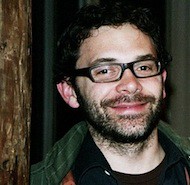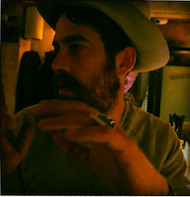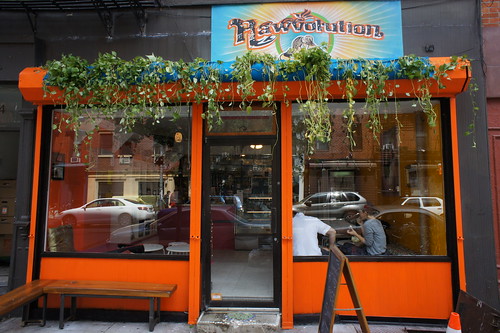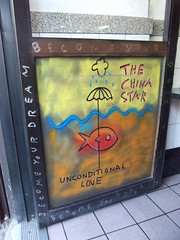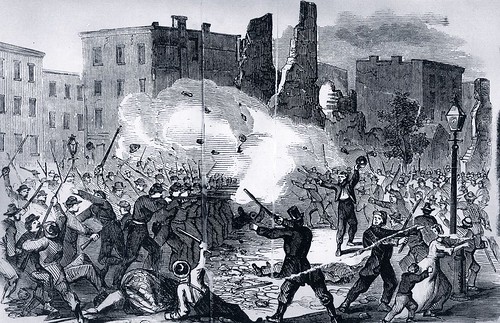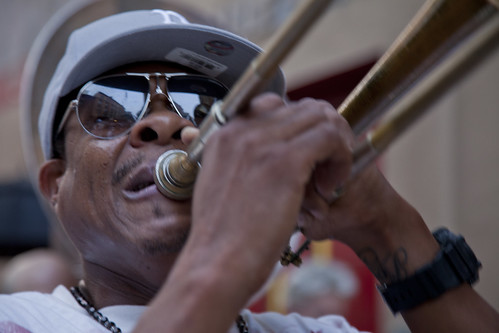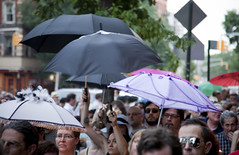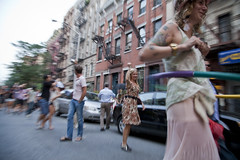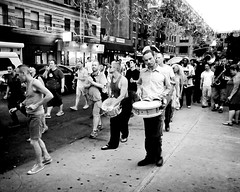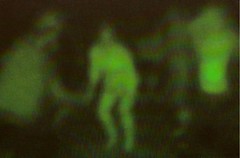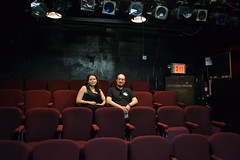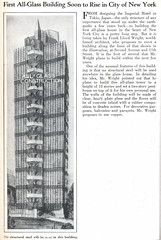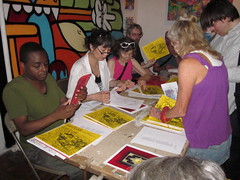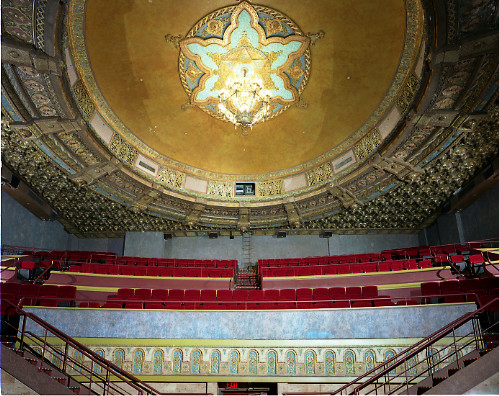With over 80 titles now published in the acclaimed series “33 1/3” (book-length critiques of particularly esteemed pop records running the gamut from “Electric Ladyland” to “Kid A”), it has fallen to Bryan Waterman, a NYU professor, to dissect Television’s 1977 recording, “Marquee Moon.” His study, which shares a title with the album in question, weighs in at a portly 222 pages (most of the books in the series are much shorter), and will delight both Television fans and nostalgists of seventies punk-era New York. Mr. Waterman explains why the album just might be the prize catch to emerge from the glory days of CBGB.
CULTURE
Notes From the Underground
By DANIEL MAURERDidn’t get your fill of abandoned subway tunnels after reading last week’s post about the 18th Street station? Paper magazine points to some MyBlockNYC footage of Steve Duncan, the urban explorer behind Undercity, traversing a “labyrinthian tangle of stuff” below the Second Avenue F-train station.
Curtis Brown Will Open The Cardinal With American Apparel’s Dov Charney as Investor
By DANIEL MAURERCurtis Brown, the former frontman of rock band Bad Wizard who became chef at Bubby’s, has left his gig at the Tribeca comfort-food standby and will open his own place at 234 East Fourth Street. Named after the bird of his home state of North Carolina (Mr. Brown was born in Asheville in 1972 and moved to New York City in 1996), The Cardinal is expected to open around Aug. 14, and will offer a “90 percent Southern” menu consisting of Memphis-style ribs, North Carolina-style pulled pork, and Texas-style brisket, as well as non-barbecue items such as lard biscuits, fried chicken, and fried pork chops with red-eye gravy. Among the restaurant’s investors is Dov Charney, the notorious founder of American Apparel.
Mr. Brown’s front-of-house partner in the restaurant is Leanne Hebert-Nguyen, who worked at the clothing company for two years (before that, she was a manager at restaurants in Montreal). “He’s a friend of hers and we were looking for investors and he got involved,” said Mr. Brown of Mr. Charney’s “hands-off” role. “He’ll be here opening night— that kind of situation. And he gives us any support he can, helping us find stuff like light fixtures for the restaurant.”
Street Art: “Walk Man” is Toppled, But Flaming Cacti Stand Tall
By KHRISTOPHER J. BROOKSThe “WALK MAN” that was erected in Tompkins Square Park over the weekend has already been vandalized (DNA Info has the story), but another art installation is still standing. Over the weekend, a group of roughly ten artists calling themselves the Animus Arts Collective transformed fourteen East Village lampposts into “Flaming Cactus” displays.
You may have seen some of the lampposts at Astor Place; four similar lampposts, festooned with fluorescent cables to resemble cacti, are located on Governor’s Island.
Officials with the New York City Department of Transportation commissioned the project in order to mark the route of the D.O.T.’s fourth annual Summer Streets program. Read more…
New Raw Food Cafe Offers Vegan Burgers, And Soon Colonics
By DANIEL MAURERThe East Village lost a raw food store when Jubb’s Longevity shuttered in 2008; more recently, it lost a vegetarian spot when Counter closed. Now, two doors down from the former Jubb’s, another raw food spot (this one a Los Angeles transplant) has opened its doors. Euphoria Loves Rawvolution soft opened at 504 East 12th Street last Thursday. Its grand opening is today, and in two weeks it will begin offering a weekly cleanse that can be supplemented with “emotional shamanic journeys” and colonics.
Traces of De La Vega
By ANNIE COFONEThe thick white chalk etched on an East Village sidewalk read:
“I JUST BOUGHT REAL ESTATE IN YOUR MIND.”
East Village artist James De La Vega once brought this existential aesthetic — and his occasionally controversial thoughts — to the streets of the East Village and then for five years to his “Museum” on St. Marks Place, which closed last year citing rent increases.
A self-described “pessimistic optimist,” his presence in clever quotes and imagery remain part of the neighborhood’s urban adornments; goldfish holding umbrellas underwater and his signature “Realiza Tu Sueño” (“Become Your Dream”) are still found throughout the area. Places including the facade of The China Star restaurant on First Avenue, the garbage cans outside Stromboli pizza shop and Porto Rico on St. Marks Place all bear the traces of his noticeable absence.
Mr. De La Vega has since moved on to new projects and has bittersweet feelings about the area: “The East Village is a powerful neighborhood,” he told us. “The locals were my favorite but I don’t miss the neighborhood.”
Mr. De La Vega’s work resonates with simple, but profound, images and rhetoric, yet he also addresses various socio-political controversies, often through illustrations and commentary on behalf of his Latino heritage. He once addressed the gentrification of East Harlem through a painted a mural stating: “Don’t think for a minute that we haven’t noticed the 96th Street boundary moving further north.”
Read more…
Local Legends | The Draft Riots
By TIM MILKThe City of New York has known the influence of many powerful men, one of whom was a man of the cloth named Archbishop John Hughes. He had, since his arrival in 1838, aligned himself with the unassimilated Irish immigrants in lower Manhattan. This Ulster-born prelate rallied them in the face of abject discrimination, (such as “No Irish Need Apply,”) yet played on their fears whenever he could. Hughes was highly ambitious, and gladly courted controversy in the press. His letters to the editor were always signed with a cross, which with a flick of his pen looked a whole lot more like a knife. And because of his fearful countenance and violent temper, reporters began to call him “Dagger” John Hughes.
That Hughes himself was a deeply bigoted fellow would not be a difficult point to prove. He regularly published his racist diatribes, and exhorted his disdain for abolitionists in numerous sermons. He whipped up his largely Irish congregation with dire warnings of freed black slaves traveling north to steal their jobs, and they heeded his every word.
By 1861, even Abraham Lincoln was terrified of Hughes, and courted his favor at the outbreak of war. He dearly wanted the “Fighting Irish” on the side of the Union, and Dagger John was flattered that Lincoln would call on him with hat in hand. He therefore wrapped himself in the flag and bid his parishioners to do the same.
Read more…
Rachel Dratch’s East Village
By ANGELA CRAVENSShe may be known for the lovably oddball characters she’s brought to life on “Saturday Night Live” and “30 Rock”, but in the East Village, actress Rachel Dratch has another mark of distinction. She’s a local.
As new mom to an infant, Ms. Dratch has been more of a homebody than usual of late, especially now that she is penning a collection of autobiographical (and, we trust, laugh-out-loud funny) stories on life after “S.N.L.”. Still, we found her to be an enthusiastic consumer of the local hangs, and with nine years as a resident of the East Village, she’s sampled more than a few of the best. Lucky for us, she was not at all timid about sharing her favorite spots.
Best Breakfast
“I like the pierogis at Veselka, and I like that it’s open 24 hours. Now that I have a baby, I don’t usually take advantage of the 24-hour thing like I used to, but I just like living in New York and knowing everything is open 24 hours.”
Read more…
Honoring Ray Deter, New Orleans Style
By LAURA E. LEEA trumpet sounded. A trombone rose. And in a mix of mourning and celebration, dozens of feet danced up First Avenue Monday night in a true New Orleans tradition — a Second Line parade honoring the life of Ray Deter, owner of d.b.a. bar who died July 3, six days after he was struck by a car while cycling.
About 150 people turned out for the march, which wove from the bar on First Avenue through the East Village and ended at Mr. Deter’s Sixth Street apartment. The procession spilled out from the sidewalks and blocked traffic for several blocks. Led by musicians, the crowd sang songs, waved umbrellas and lit candles in memory of their friend.
Linnzi Zaorski, a jazz singer, offered an a capella song in memory of her friend as the parade paused in front of the New York City Marble Cemetery where Mr. Deter’s memorial service will be held on Wednesday. Then she looked up, smiled and blew a kiss towards the sky. “We love you, Ray,” she said, as the brass music began again.
Sounds of the Second Line
The Local’s Laura E. Lee and Chelsia Rose Marcius share their video of Monday night’s Second Line parade honoring Ray Deter.
Night Vision at Y Gallery
By TIM MILKThe subjects lurch to and fro in a drunken, slow-motion dance across the barroom floor, enveloped in a thick and sultry green fog. Then the action cuts to a solitary young woman who stares silently through this murk into a computer, until you the viewer turn away to find distraction in a barren art gallery as if possessed by a waking nightmare.
Such is what Juanli Carrion’s wall-sized video brings to the eyes in an exhibition entitled “The Plague of Darkness,” at Y Gallery on Orchard Street. The green-tinged night-vision technology so valued for military applications is employed here by Mr. Carrion to evoke its authoritative intrusion on a very personal level.
The work of other Latin American artists was also on display. Some speak to the history of totalitarian regimes in their native countries, and the will of the artists to survive them. Associate director Yoab Vera, himself from Mexico City, guided me through the gallery, and explained that although Y Gallery’s representation was 50 percent Latin American, the true goal was to open a dialogue between cultures, theirs and ours.
Y Gallery is located at 165 Orchard Street, between Rivington and Stanton. The exhibit runs through July 31.
A Theater Turns Hardship Into Hope
By IAN DUNCAN Ian Duncan When 94 St. Marks Place was put up for sale, owners of the basement theater launched a campaign to buy the building. Below, Heidi Grumelot and Erez Ziv of Horsetrade, the theater’s owner.
Ian Duncan When 94 St. Marks Place was put up for sale, owners of the basement theater launched a campaign to buy the building. Below, Heidi Grumelot and Erez Ziv of Horsetrade, the theater’s owner.It was an e-mail message from the blogger EV Grieve that first alerted the Horse Trade performance group that a building that served as the home to one of its theaters was up for sale. The news was a shock to co-founder Erez Ziv and artistic director Heidi Grumelot — and apparently to the landlord, who, they say, was not expecting the brokers to move so quickly. The asking price was just shy of $6 million.
Grieve asked darkly whether the sale would mean the end for the 45-seat theater, but Mr. Ziv sprang into action and Horse Trade is now running a campaign to buy the building for itself and turn it into a haven for theater people — a sort of off-off Broadway bed and breakfast for companies from around the world. There, actors, performers and writers could collaborate, sharing ideas and hatching new projects.
The plan shows the ambition of Horse Trade, a company with influence across New York’s theater world, but which is also in a precarious position shared by many independent theaters in the neighborhood. In the last few years, a number of venues have closed down, shutting off opportunities for new performers and writers to test ideas. But the East Village shows some signs of health — a 2008 study found it was home to only 14 percent of New York’s independent theaters, but 27 percent of the city’s performances.
Read more…
On 10th St., Towers that Never Were
By IAN DUNCAN Ian Duncan St. Mark’s in the Bowery as it looks today, and below, a rendering of one of the towers that might have stood on the site, courtesy of Modern Mechanix.
Ian Duncan St. Mark’s in the Bowery as it looks today, and below, a rendering of one of the towers that might have stood on the site, courtesy of Modern Mechanix.Frank Lloyd Wright is probably not a name to make the hearts of preservationists quake. But if the architect had had his way, tonight’s debate on a new East Village historic district would have been held in a very different context.
In the late 1920’s, Wright proposed tearing down the row houses on East 10th and Stuyvesant Streets and building over the cemetery at St. Mark’s in the Bowery to make way for four glass skyscrapers. Plans held by the Museum of Modern Art show the church crowded in by the towers: at 19 stories they would have rivaled the Cooper Square Hotel for size.
And just as two East Village clerics have come out as opponents of the preservation area, it was The Reverend William Norman Guthrie, the rector of St. Mark’s, egging Wright on.
The church’s once-affluent congregation had been whittled away as the Lower East Side became a home to immigrants. Guthrie approached Wright in 1927, commissioning him to design an apartment tower on church land, hoping the rent would restore its ailing finances.
“At that time, Wright’s career was in the doldrums,” said Hilary Ballon, an expert on his work and deputy vice chancellor of NYU Abu Dhabi. “Getting to build a skyscraper in New York was a great restart.”
Read more…
Foes of Historic District Plan Emerge
By STEPHEN REX BROWN David Jarrett The leaders of two local houses of worship have emerged as critics of the proposed historic district in the East Village.
David Jarrett The leaders of two local houses of worship have emerged as critics of the proposed historic district in the East Village.Thus far, the proposed East Village historic district has been met with relatively little opposition — but that looks as if it is going to change.
The leaders of two local houses of worship have emerged as outspoken opponents of the proposed district in the neighborhood, which they say would lead to unnecessary expense and bureaucratic inconveniences.
Rabbi Pesach Ackerman of the Congregation Meseritz Syngg on Sixth Street and Father Christopher Calin of the Orthodox Cathedral of the Holy Virgin Protection both bristled at the notion that they would have to get approval from the city Landmarks Preservation Commission before renovating the exteriors of their religious institutions.
“Once you’re landmarked, you’re not the owners of the building anymore,” said Mr. Ackerman, who has been the Rabbi of Meseritz Syngg for 42 years. “Anything you do, you have to ask their permission.”
Representatives from both institutions, along with those in favor of the district, are expected to speak on Thursday during a meeting of Community Board 3, which will be dedicated to the proposal.
Read more…
In the Park, A Film Free-for-All
By JOSHUA DAVIS Joshua Davis The EPIX Movie Free-for-All is the first sponsored weekly film series held in Tompkins Square Park. Screening will take place Thursday evenings through Aug. 25.
Joshua Davis The EPIX Movie Free-for-All is the first sponsored weekly film series held in Tompkins Square Park. Screening will take place Thursday evenings through Aug. 25. The East Village, with its history of art house theaters and independent video stores, has long been a destination for movie lovers. But for countless summers, East Villagers have had to trek uptown or head to out to Brooklyn to participate in a summer tradition: outdoor movie screenings.
That all ended last night when the EPIX Movie Free-for-All premiered its weekly film series in Tompkins Square Park with the screening of Martin Scorsese’s “Raging Bull.”
“When we saw it was right here, and we could run and use the bathroom in our own apartment we were like, ‘let’s go,’” said Polly Seplowitz, 27, a nearby resident and public school teacher who came with her neighbor.
The series is the first sponsored weekly film event held in Tompkins Square Park, and organizers say they are pleased to bring an event patterned after the popular HBO Bryant Park Summer Film Festival to the East Village.
Read more…
Assembling Art, Page by Page
By MEGHAN KENEALLYNearly two dozen people walked past the “For Sale” sign and closed gate of a townhouse on Third Street on Sunday, invited themselves in the unlocked door, and made their way up to the second floor with folders of their work in tow.
When they walked in, it was like a mini reunion of yesteryear’s East Village art world: everyone knew each other, liked each other’s work, and swapped stories about peers of old.
And then they got to work publishing a magazine.
They were all there to put together the 34th issue of “What Happens Next,” an assembly magazine made up of poems, collages and drawings. The event, and the 33 issues prior, have been organized by Eve Packer who started it “just to have a forum” for the work of she and her friends, and anyone else who wanted to jump in.
The magazine is made up of individual work provided by the participants, with each bringing 100 copies of their pieces. The assembly aspect of the magazine is very literal: everyone lines their stack up and they start passing it along, with one person at the end taking charge with a stapler.
Read more…
The Yiddish Walk of Fame
By ANNIE COFONEOn the corner of 10th Street and Second Avenue, the neon blue of the glass Chase Bank building beams among the many signs and street lights. Yet this particular site casts a stage-light glow on the now-oxidized, brassy stars embedded in the sidewalk, embossed with Jewish names.
This is the Yiddish Walk of Fame.
The placement of these stars is a reminder of a former culinary institution (some might say shrine) that once occupied this coveted address, the Second Avenue Deli. From 1954 to 2006 the restaurant was an East Village staple, founded, owned and operated by the locally beloved Abe Lebewohl. The park across the street was re-named for Mr. Lebewohl after his murder in 1996.
Although the Second Avenue Deli had to vacate its historic setting (it has since relocated to 33rd Street and Lexington Avenue in Murray Hill) it was originally centered among a unique and ubiquitous string of Yiddish theaters along Second Avenue: what Josh Lebewohl — nephew of Abe and co-owner of the deli with his brother Jeremy — calls, “The Jewish Broadway of its time.”
Read more…
Looking Back | The Fillmore East
By STEPHEN REX BROWN Amalie R. Rothschild A huge crowd formed around the Fillmore East in May 1970 when tickets went on sale for Crosby, Stills, Nash and Young.
Amalie R. Rothschild A huge crowd formed around the Fillmore East in May 1970 when tickets went on sale for Crosby, Stills, Nash and Young.The push to preserve blocks of the neighborhood through a landmark district has, not surprisingly, led to a lot of conversations about the history of the area. The proposed district covers roughly six blocks, and perhaps no property within the tract has hosted more important figures in American culture than the former Fillmore East building at 105 Second Avenue.
Now, the entrance to the building is an Emigrant Savings Bank, and the 2,600-seat theater has been replaced with an apartment building. But the Fillmore’s three-year existence had a lasting impact culturally; Jimi Hendrix, Joe Cocker and Miles Davis all recorded well-regarded live albums there. The Who played their rock opera, “Tommy” in its entirety for the first time in the United States in 1969 at the Fillmore East. And the first rock concert to be broadcast on television was taped there in 1970.
But the Fillmore’s impact went beyond the performers onstage. Numerous technological innovations during the theater’s short existence were adopted at concert venues across the country.
“I was blown away by what a creative, experimental theater environment there was at the Fillmore East,” said Amalie R. Rothschild, a photographer who was among the many NYU students who landed dream jobs at the Fillmore when it opened in 1968. “It was a real place to do real things. The students had a live laboratory within which to work.”
Read more…
Sounds | Iceage
By JENN PELLYAs the humidity broke on Wednesday around 7 p.m., umbrellas hid the growing line outside of Other Music, the record shop on East Fourth Street. The rainfall cooled the crowd, but it was no match for the utter coldness these show-goers were waiting for: a live performance from the much-hyped Danish punk band Iceage. Watch a clip of their set — dark, piercing, and endearingly sloppy — above.
It was Iceage’s third New York set, following their sold out, stateside debut on Friday at Williamsburg’s Northside Festival. The teenage quartet — fronted by Elias Bender Ronnenfelt, 19 — plays the DIY venue 285 Kent in Williamsburg on Saturday with other bands, including Jeff the Brotherhood. Iceage’s debut LP, “New Brigade,” is out now.
St. Marks Place in 20 Years of Photos
By STEPHEN REX BROWN Stephen Rex Brown A new gallery exhibit by Jesper Haynes chronicles 20 years of living in the East Village.
Stephen Rex Brown A new gallery exhibit by Jesper Haynes chronicles 20 years of living in the East Village.Plenty of longtime locals love talking about the good old days in the East Village, but Jesper Haynes can point to his photography as proof of what a great time he had in the neighborhood.
“St. Marks: 1986-2006” is an exhibition of Mr. Haynes’ photographs taken inside his two-and-a-half bedroom apartment at the corner of First Avenue and St. Marks Place that is opening this evening at Gallery Onetwentyeight on the Lower East Side. A diverse group of close friends, pretty girls and kooky characters are shot in various states of undress, intoxication, and exuberance.
Read more…
An Honor for the Poet Bob Holman
By CARY ABRAMSThis evening the Greenwich Village Society for Historic Preservation gathers for its 31st annual meeting and presentation of awards to honor individuals, groups, businesses who have made significant contributions to the area. This year’s winners include Bob Holman, founder of the Bowery Poetry Club, and the Fourth Arts Block.
Founded in 1980, the society is dedicated to preserving the architectural heritage and cultural legacy of Greenwich Village, the East Village, NoHo, the Gansevoort Market, and South Village. Their myriad activities include historical and architectural research, lectures, tours and publications. Currently, the group is at the forefront of the effort to designate parts of the East Village as historic landmarks.
Bob Holman has been tirelessly involved in promoting poetry and the arts on the Lower East Side during the past four decades through a host of activities. Most recently, he emceed the reading of Allen Ginsberg’s epic “Howl” at Howlfest. He served as coordinator of the Poetry Project at St Mark’s. In 1987, he helped reopen the Nuyorican Poets Café where he served as slam master for newly introduced poetry slams.
In 2002, he realized a vision in founding The Bowery Poetry Club, a venue where poets, musicians, playwrights and artists are able to present their work seven days a week.
Tonight’s event, which is open to the public, begins at 6:30 p.m. and is being held at The Village Community School located at 272 West 10th Street. Come and join the festivities.



